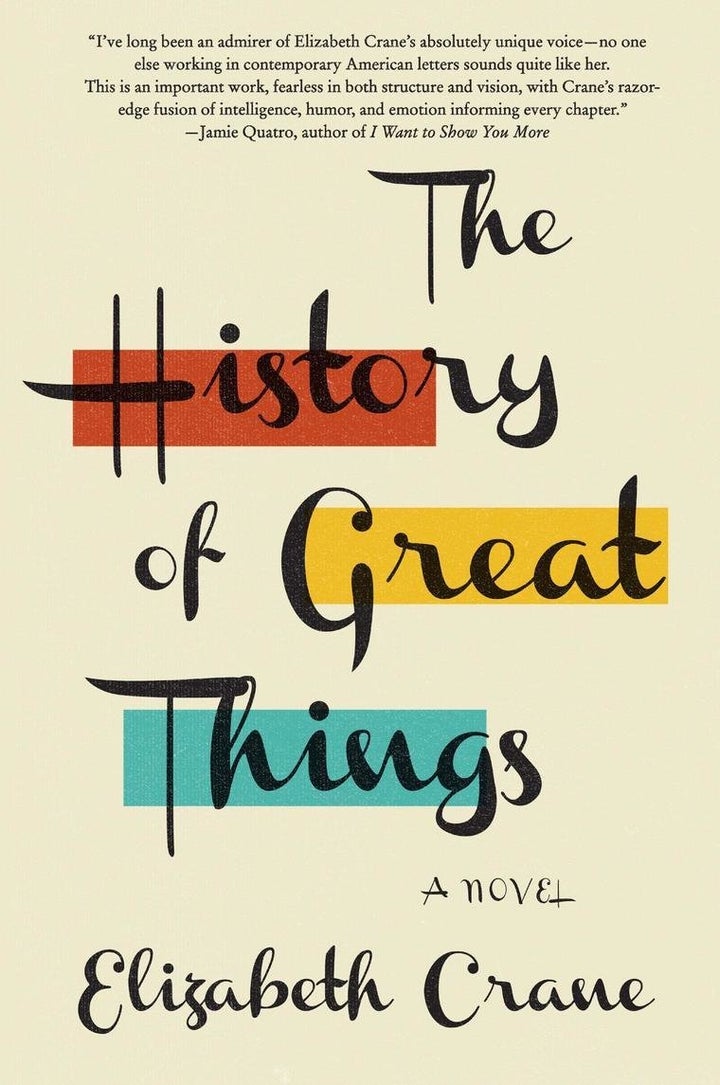
The first person everyone meets is her mother. Whatever else may follow, she's there from the start, and her presence, or absence, looms.
It's a truth that sounds throughout literature, not to mention psychotherapy -- your mother is accountable for your neuroses, your ambitions, your wants and your fears. That's the case, at least, for Betsy Crane, one of the two narrators in Elizabeth Crane's inventive new novel, The History of Great Things. The other narrator, as it were, is her mother, Lois.
Chapter by chapter, the pair works to tell each other’s life stories, embellishing or altering the truth wherever possible, and in doing so revealing their own biases and opinions. While Betsy is prone to writing emotionally honest if melancholic accounts of her mother’s life, Lois is hyperbolic, penning high highs and tragic lows.
This makes sense, given that she’s built a career as a successful opera singer. Betsy’s account of her mother’s artistically ambitious life begins in Muscatine, Iowa, where she was born in 1936. Hazy on the details, Betsy begins conversationally, glossing over fits of the croup, and giving extra care to scenes that she views as formative: Lois’ father’s horrible rage after she has a black friend over to play, her sister’s off-putting aloofness when their West Highland Terrier dies under the porch. These stories are related casually but with gravity, reflecting the tone of time-worn, passed-down tales.
Lois uses the same approach when telling Betsy’s story, but she’s inclined to reveal her maternal concern for her daughter’s well-being, especially during Betsy’s aimless post-college years, spent waitressing, drinking, writing and bouncing between New York, Los Angeles and Chicago. Although she takes after her mother physically -- both are beautiful, and sought-after -- she’s less focused when it comes to romantic pursuits or career ambitions.
The pair’s differences are revealed in their witty exchanges at the end, or in the middle, of each chapter. They interject, amend, bicker, and reveal their warring perspectives on art, storytelling and their own fraught relationship. While Betsy believes her mother encouraged her not to pursue the arts, contributing to her own lack of drive, Lois begrudges Betsy, occasionally admitting to herself that motherhood interfered with her otherwise fated success.
At times, these quippy asides veer into the conceptual, distracting from an otherwise warm and uniquely told story. There’s talk of “POV,” and the value of novels-from-life versus straightforward memoir. But, the post-chapter conversations also work to reveal a touching truth about Betsy’s project: these conversations with her mother are taking place in her head, as a means of working through her own thoughts about their relationship.
The insular world created by her imagined conversations speaks to just how encompassing one’s relationship with her mother can be.
After she dies from lung cancer at 60, Lois, as written from Betsy’s perspective, sweetly says to her daughter, “Look at you. You’ve done better without me.” To which Betsy replies, “You were there for thirty-seven years of my life. There is no me without you.”
The bottom line:
Crane’s inventive novel of loss and reflection is told in the alternating perspectives of a headstrong mother and her daughter. Though sometimes too clever for its own good, the book brims with warm revelations.
What other reviewers think:
Kirkus: "Her mother is right: one wishes this endearing stylist, reminiscent of Elizabeth Gilbert, would have done it the easy way. A memoir would have been just fine."
Publisher's Weekly: "Peppered with touching moments in which the women find unexpected common ground, as well as hilariously snarky asides between Betsy and Lois at the end of each chapter, the mother-daughter dynamic feels genuine. However, the gimmick of an author named Elizabeth Crane writing about a character named Elizabeth (“Betsy”) Crane strains the book, and the narrative voices are so similar it’s often hard to tell where Lois cuts off and Betsy picks up."
Who wrote it?
Elizabeth Crane is the author of We Only Know So Much, which will be released as a film this year. She’s also the author of three collections of short stories.
Who will read it?
Anyone interested in unconventional narratives a la Sheila Heti or “Adaptation.” And, of course, those interested in stories about familial relationships.
Opening lines:
"You’re late. Two weeks, forty-one hours late, nine pounds, ten ounces. That’s a lot. That’s like a bowling ball coming out of me."
Notable passage:
"You and Victor have been married for five years now. You love him, in your way; he adores you, still, always. You fight, loudly, sometimes every day. You always, always believe that each fight will be the last, though evidence over time suggests otherwise. Notably, in one of these fights, the kitchen telephone gets ripped off the wall on New Year’s Eve.
"-I think it was Christmas Eve, Betsy.
"-Okay, it doesn’t matter."
The History of Great Things
By Elizabeth Crane
Harper Perennial, $14.99
Published April 5, 2016
The Bottom Line is a weekly review combining plot description and analysis with fun tidbits about the book.

